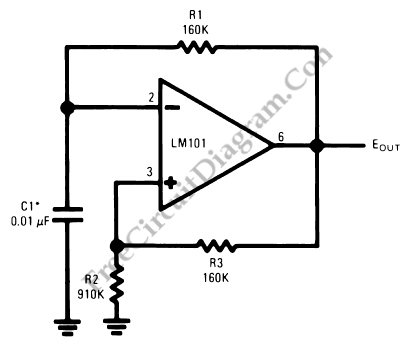Operational Amplifier (Op-Amp) Oscillator
This is Operational an Amplifier (Op-Amp) Oscillator circuit. This circuit has some advantages, they are this circuit can be operated at low frequencies with relatively small capacitors, it has a completely-symmetrical output waveform along with a buffered output and it will always self start and cannot hang up because there is less dc positive feedback than negative feedback. Returning R2 to some voltage other than ground will change the symmetry. Here is the circuit :

The usual frequency compensation components (capacitor and resistor across pin 1 and 8) are not needed in this circuit because the operational amplifier is used in open-loop configuration. It will only slow the performance if we use frequency compensation components. Moreover, the use of the circuit is restricted to frequencies below about 2kHz by the speed limitations of LM101, even without a 30 pF compensation capacitor.
The C1 acts as timing capacitor that is produces several times constants which is used to permit large voltage swings on the input due to the LM101’s large input voltage range. To keep from exceeding these ratings, the R2 should be reduced and increase the C1. The smaller polarized capacitors is still used, although C1 requires the large values, by returning them to positive supply voltage instead of ground. [Source: National Semiconductor Application Note]